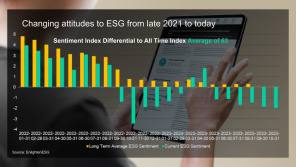

Simon Holmes, lead manager for BMO GAM’s Sustainable Universal MAP range, told FTAdviser that ESG investing was “one of the most problematic parts of the market” for intermediaries, particularly when matching a client’s ideals with the products on offer.
He said: “It’s a big topic and a relatively new one. It’s one thing for us as fund managers to create products and know what we’re doing, but if you’re an adviser, you’re expected to understand all this when they’ve only been created in the past few years.”
According to Mr Holmes, advisers could help navigate the minefield by clarifying, both with fund managers and clients, exactly what was meant by the jargon associated with environmental, social and governance investing.
He said: “It matters to be very clear on what the jargon means. Impact, sustainable, ESG, all feel like they’re the same until they are explained, so having that clarity on labels is important.
“Regulatory and industry bodies have gone some way to pin down definitions but investors need to know that even if you call it ESG, a fund can still own energy companies.”
Mr Holmes said advisers should ask fund managers for the precise parameters of the fund — “ask what can you own, what can’t you own, what are holdings, what is the policy?” — and ensure the same standards are applied to both equities and corporate fixed income.
Understanding a client’s “red lines” within ESG was also important in finding the right fund for the job, Mr Holmes added.
He said: “When you ask a client what they want, you need to allow them to answer properly. I would show them a list of sectors and ask, which of these would you be uncomfortable with? Or what are your goals within this list? What do you want to avoid?
“By finding a client’s red lines and being really clear about what they want, the adviser won’t get a surprise from that end.”
It is also a smart move to “be realistic” with clients about the potential shortcomings of ESG, both in terms of the industry itself and the companies it invests in, he said.
Mr Holmes said: “You cannot get the perfect company. What would it even look like? Companies themselves are all evolving.
“The best starting point is to be honest — if companies can be honest about what they are doing and what they can get better at, and advisers can be honest about the fact everything is evolving and learning, then that is as good as you can get and this will lead to progress.”
His comments come after the BMO GAM Sustainable Universal MAP range reached its first year anniversary, having launched in December 2019.
Risk rated across cautious, balanced and growth, net of all costs the funds returned 12.6, 14 and 14.1 per cent respectively in their first year since launch.
The cost of the actively managed sustainable range is capped at 0.39 per cent, and the managers focus on strategic asset allocation and sustainable stock selection.
Within its sustainable aims, the funds use an ‘avoid, invest, improve’ strategy.
The range ‘avoids’ weapons, tobacco, fossil fuels and companies with severe breaches of UN conduct, and aims to ‘invest’ in companies making the world better, primarily based around the UN sustainable development goals.
Managers also work with companies on “what they don’t do so well”. Throughout 2020, BMO GAM engaged with 58 companies within the portfolio and recorded 37 “milestones” relating to governance, climate change and environmental standards.
Rob Thorpe, head of UK intermediary sales, said: “This range responds to three growing areas of demand among advisers and their clients — active multi-asset, sustainable investments and a low charge.
“A focus on low-cost solutions has previously acted as a barrier for advisers and clients to active solutions, with passive investments becoming a default as a result.”
Mr Thorpe said these funds had “removed the price advantage of passive strategies” and enabled advisers to make a direct comparison between the approaches.
imogen.tew@ft.com
What do you think about the issues raised by this story? Email us on fa.letters@ft.com to let us know



